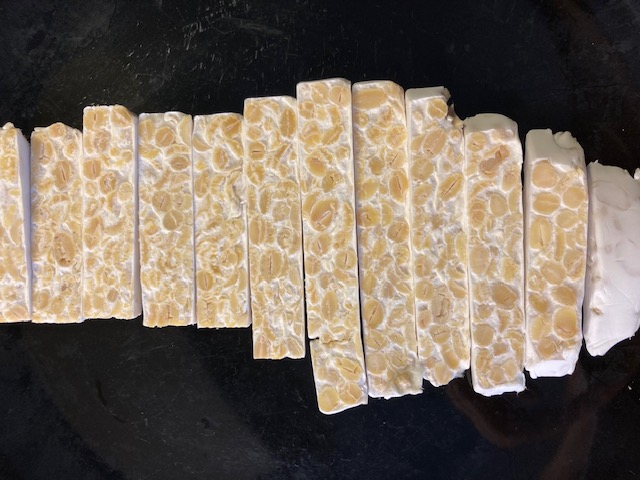Making Tempeh
let’s use fungi to convert beans into delicious tempeh
 thinly sliced yellow soybean tempeh on a black plate
thinly sliced yellow soybean tempeh on a black plate
Steps
These are the general steps involved in processing dry soybeans (or other kinds of beans) into fresh, homemade tempeh.
- Weigh and soak beans
- (Dehull beans - buy dehulled beans if possible, way less effort)
- (Pressure) Cook beans in acidic solution
- Strain, cool down, and dry off cooked beans
- Mix beans with rhizoporus oligosporus spores
- Spread beans into fermenter containers
- Ferment
- Collect
Weigh and soak beans
Use 40-50g dry tempeh beans per petri dish to be fermented, depending on diameter of dish.
Soak the beans for 12-24 hours.
(Pressure) Cook beans in acidic solution
Measure up 1 msk (15 ml) 12% white vinegar per liter of water to be used. For 200g (dry weight) of beans it’s OK to use 1 liter water.
Boil hulled soybeans in the acidic water for:
- 75 minutes [regular pot]
- 40-50 minutes pressure cooker (40 minutes active time, 10 minutes ‘natural release’)
Using a pressure cooker goes a lot faster and helps thoroughly cook the beans.
Strain, cool down, and dry off cooked beans
Strain cooked beans into a colander. Don’t rinse with water as the beans are currently sterile.
Pour the beans back into the hot pot to briefly “steam” them, getting rid of excess moisture.
Spread the beans out on a counter that has been covered with a freshly cleaned fabric towel.
Cool down and steam off for 15 minutes. After 15 minutes, take another towel and dry the beans to make sure there is no excess moisture.
Mix beans with rhizoporus oligosporus spores
Pour all the beans into a clean bowl or lunch box and incoulate with spores:
- Use 0.5 krm (0.5 ml) per 200g dry weight of beans commercial rhizoporus oligosporus spores.
- Use 1 tsk (10 ml) if using homemade rhizoporus oligosporus spores.
Sprinkle the spores over the beans in the container. Put a lid on the container and shake vigorously. (Wear a mask if concerned with inhaling spores).
Spread beans into fermenter containers
Dish out the beans into petri dishes.
Don’t overpack the petri dish. I make a little indentation in the center of the dish as that’s otherwise a spot susceptive to rot.
Ferment
Put petri dishes into fermenter for 48 hours. Be aware of the timing of the process, from start to finish, so that you are able to collect the beans when they are done.
Collect
If the beans are a little black on edges close to their fermenting container’s air intake that’s just a sign of mature spores. As long as the texture is firm, the tempeh is not slimy, and there is no strong ammonia or alcohol smell (and no green/blue mold) it is perfectly edible.
Cool down the active fermentation by placing the containers in a fridge over night. Fresh tempeh can be stored in the fridge for 3-5 days, or frozen for several months.
Prepare the tempeh: marinating and frying, deep frying, steaming. Eat!
Resources
- Domingo Club’s tempeh resources:
- https://domingoclub.com/docs/how-to-make-tempeh
- https://github.com/domingoclub/website/blob/7897f4fc1333f87f4039f8501359f8b964e0f2d5/content/2021-04-06-food/2021-04-06-tempeh/2022-01-20-tempeh-making/2021-04-06-soy-tempeh/_index.md
- https://github.com/domingoclub/fermenter-software/tree/6b3a5fdacade12afc05e87a72c2038c31f100579/software
- cooking/tempeh